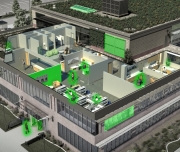The commercial cleaning industry in the U.S. annually uses 8 billion pounds of chemicals annually.1 These chemicals, as well as operations and maintenance practices, have a tremendous impact on indoor environmental quality. Integrating sustainable O&M plans, procedures, and technologies into everyday maintenance will ensure long-lasting Health Impacts are continued.
1. LEED Existing Building Operations and Maintenance Reference Manual
A successful Green Cleaning Plan limits the exposure of building occupants and maintenance personnel to potentially hazardous chemicals, ensures proper custodial effectiveness, emphasizes the use of resource-efficient cleaning products and equipment, and can reduce cost through reduced use of cleaning products and more efficient use of maintenance staff time. A Green Cleaning Plan is essential to ensuring long-lasting IEQ benefits are maintained. Avoid the use of toxic cleaning products by specifying environmentally-conscious and certified alternatives. In a similar manner, cleaning equipment and systems should utilize toxic-free techniques that still provide the desired outcome. Creating a plan that outlines cleaning schedules and procedures while systematically evaluating its own effectiveness will ensure IEQ is cost-effectively maintained throughout the building’s life cycle.
Integrated Pest Management (IPM) is an economically and environmentally sensitive approach to pest management that utilizes preventative measures, monitoring & maintenance of identified pests, and minimal use of least-toxic chemical pesticides in targeted areas for a targeted species to create a solution that provides the least hazards to people, property and the environment. By utilizing IPM principles, internal pest problems can be mitigated in an efficient manner that uses the least amount of pesticides and resources, since many IPM solutions involve permanent and physical barriers. EPA’s Building Assessment Study and Evaluation (BASE) study of 100 office buildings found that 15% percent of the buildings had no interior pesticide applications and 33% of the buildings had no exterior pesticide applications.1 Effective IPM ensures the health of the building its occupants, and the environment are maintained.
1. EPA | Building Assessment Survey and Evaluation (BASE) Study
Incorporating an entryway dirt capture or walk-off system by the exterior doors collects indoor pollutants that would otherwise be introduced into the indoor environment or need to be cleaned by custodial staff. Up to 24 pounds of dirt can be tracked in by just 1,000 people during a 20-day work period, costing on average $500 to remove per pound.1 As a result, integrating an entryway system can prevent not only dirt circulation but save money on overall upkeep costs.
1. "The Importance of Entryway Matting", Facilities Magazine
Moisture can enter the office building in a number of ways, including leaks in the building envelope and plumbing systems or excessive moisture in the circulated air. Moisture can also be generated by internal activities such as cooking and the respiration of people and plants. EPA’s BASE study found that of the 100 commercial office buildings evaluated, 85% had past water damage and 45% had current water leaks.1
Moisture and dampness facilitates mold growth, which cause adverse health effects, and can lead to costly damages of interior products and systems. Mold also produces allergens and other irritants that affect the respiratory tract causing symptoms including asthma and hay-fever type reactions such as sneezing, runny nose, red eyes, and skin rash. Mold can be found almost anywhere and mold spores will grow on any organic surface that is moist and exposed to air. The conditions that lead to mold growth also lead to other biological contaminants including fungi, mildew, and various bacteria. A 2013 NIOSH Alert by NIOSH provides additional background on the health risks associated with damp buildings and provides tips to building owners, facility managers, and occupants on how to identify and deal with those risks. The key to controlling mold and mildew indoors is moisture control and removal of mold-contaminated materials that cannot be cleaned. Moisture control techniques include dehumidification systems, submetering of water lines, and meticulous evaluation of the building’s envelope, foundation, and roofing systems.
1. EPA | Building Assessment Survey and Evaluation (BASE) Study
Systems can malfunction, drift out of spec, or become obsolete over the life time of the building. It is important to commission and regularly re-commission building components, such as the entire HVAC, Water, and Lighting systems to ensure that their functionality is maintained and indoor environmental quality is not compromised. Adequate access to these system components must be accounted for to allow for testing and evaluations to take place. Consider issuing an occupant survey prior to any re-commissioning actions to identify areas were more resources should be allocated.

